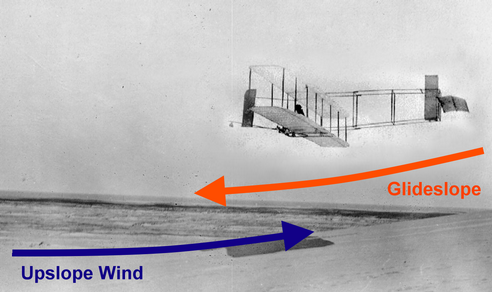|
 n
1911, Orville and Wilbur Wright planned a return to Kitty Hawk,
NC for another round of gliding experiments. The stated
purpose of the trip was to test an automatic stabilizer – a
primitive autopilot – that the brothers had been developing since
1905. Correspondence between the two suggests they had another,
private goal – to finish what they started when they first came to
Kitty Hawk and create a true soaring machine. The Wrights were among
the first scientists to realize that the wind moves vertically as
well as horizontally. A glider in an updraft that descends at the
same rate as the air is rising can remain aloft indefinitely. n
1911, Orville and Wilbur Wright planned a return to Kitty Hawk,
NC for another round of gliding experiments. The stated
purpose of the trip was to test an automatic stabilizer – a
primitive autopilot – that the brothers had been developing since
1905. Correspondence between the two suggests they had another,
private goal – to finish what they started when they first came to
Kitty Hawk and create a true soaring machine. The Wrights were among
the first scientists to realize that the wind moves vertically as
well as horizontally. A glider in an updraft that descends at the
same rate as the air is rising can remain aloft indefinitely.
To this end they built an
experimental glider that could ride the upslope winds at Kill Devil Hills.
At first glance, the glider looked similar to the powered Wright
“Model B” aircraft, but it was actually a completely new design. The
wings were patterned after the Wright “Model EX,” but much lighter.
The rudder design was untried, although it would become standard
fare on later aircraft. Additionally, the glider evolved as it was
flown. First, Orville extended the distance between the tail and
wings 4.5 feet (1.4 meters) to make the rudder and elevator more
effective. When that proved insufficient, he added a “blinker”
(vertical stabilizer) and a larger elevator. Both parts were
salvaged from the
Wright Flyer III
which Orville and Wilbur had left
in Kitty Hawk in 1908. Finally, he adjusted the center of gravity by
hanging a bag filled with 12 pounds (5.4 kilograms) of sand in front
of the aircraft.
The 1911 Wright Glider specifications, in its final configuration:
- 32 ft (9.6 m) wingspan
- 5 ft (2.1 m) chord
- 1/24 camber
- 3.6 ft (1.1 m) separation
- 300 sq ft (27.9 sq m) wing area
- 28 sq ft (2.6 sq m) rear elevator area
- 13.5 sq ft (1.3 sq m) rudder area
- 28.7 ft (8.7 m) length (including sand counterweight)
- 170 lbs (77.1 kg) weight (including sand counterweight)
Wilbur unfortunately could not make the trip to Kitty Hawk – he
had just gotten back from Europe in August of 1911 after being gone
since March. In addition to being sick of traveling, he was snowed
under by legal obligations generated by the Wright Company's patent suits. Orville left Dayton on 7 October 1911 with
his brother Lorin, his nephew Horace, and a pilot-friend from England,
Alec Ogilvie.
Orville and Ogilvie made about 90 flights in the glider at Kitty
Hawk. These first attempts at soaring were as challenging as
anything the Wrights had ever done. Orville would later report, "Flying
in a 25-meter-per-second (about 55 mph) wind is no snap, and I can
tell you that it keeps one pretty busy with the levers." The glider
overturned twice in the high winds, crashing to the ground. Plans to
test the stabilizer evaporated; the air was much too rough.
On
24 Oct 1911 Orville found the right wind. He took off in a 40 mph (64.3
kph) upslope wind gusting up the sides of Kill Devil Hills. He
quickly rose to an altitude of 50 feet (15.2 meters) and remained
there for 5-1/2 minutes. He flew again, gliding for 7-1/4 minutes.
And again, soaring for 9-3/4 minutes, seeming to hang motionless
over the same patch of sand. These were the first recorded soaring
flights, the last one setting a record that would stand for ten
years. Orville sent a triumphant message to Wilbur saying, “All our
theories are proved.”
The 1911 glider was abandoned at Kitty Hawk, stored in the
shed with the remains of the Wright Flyer III. It stayed there
until 1914 when Zenas Crane obtained Orville's permission to salvage
both aircraft for the Berkshire Museum in Pittsfield, MS. Crane did
a poor job of restoring the glider, so much so that it infuriated Orville and the
glider was never exhibited. It is thought to have been discarded at
some point before 1946 when the Flyer III was
transferred to
Carillon Park in Dayton, OH.
References:
- McFarland, Marvin W. (ed) The papers of Wilbur and Orville Wright.
McGraw-Hill Book Co., New York, 1953, p 1183, plates 198-201.
- Crouch, Tom D., The Bishop's Boys, A Life of Wilbur and Orville
Wright. W.W. Norton & Co., New York, 1989, pp 444-445.
[Submitted by Joe W. McDaniel]
|

The Wrights theorized that if the flying speed and glide slope of
the glider was equal to or less than the speed and angle of the
upslope wind, the aircraft could ride the wind indefinitely,
appearing to hang in the air above the sand.
|